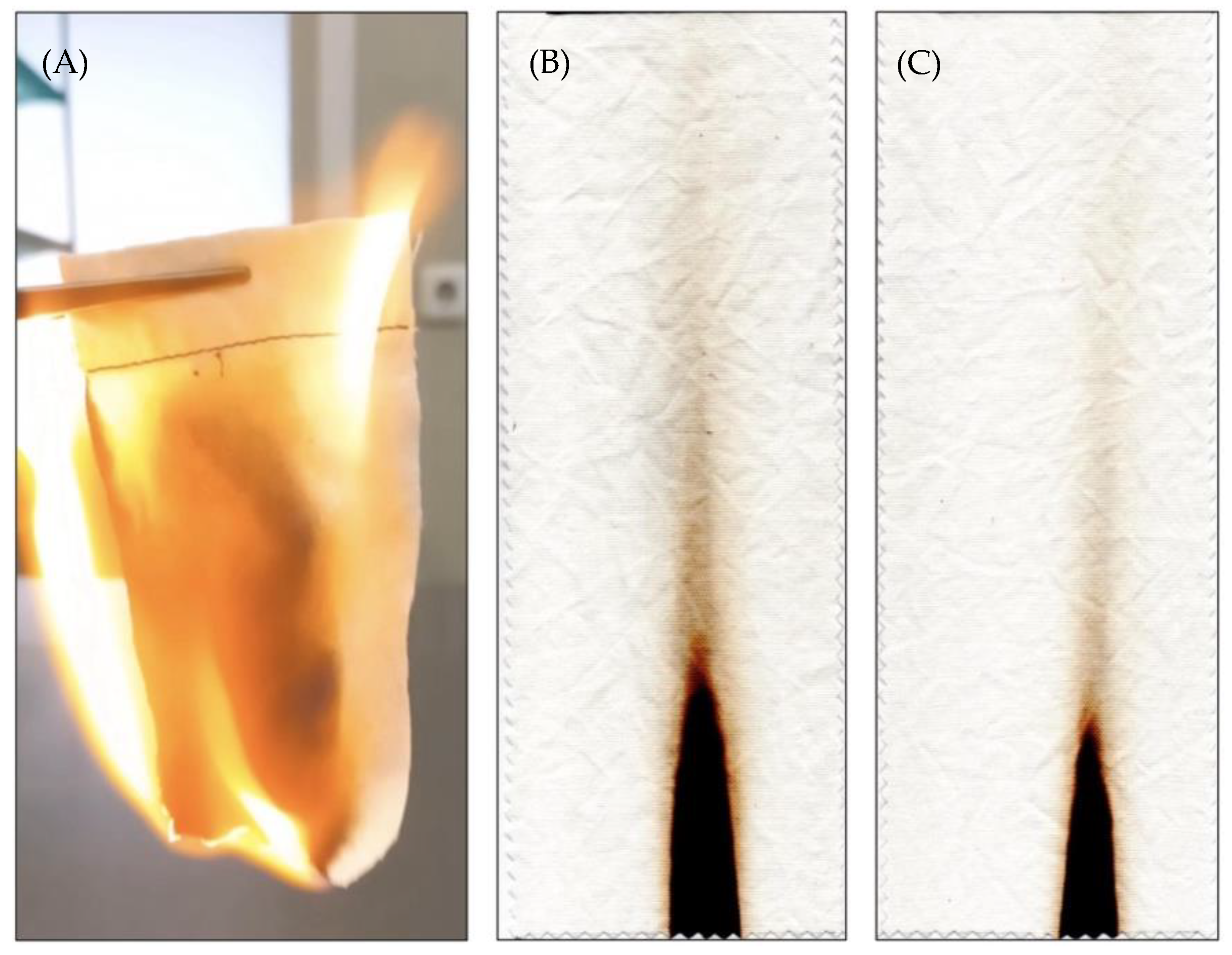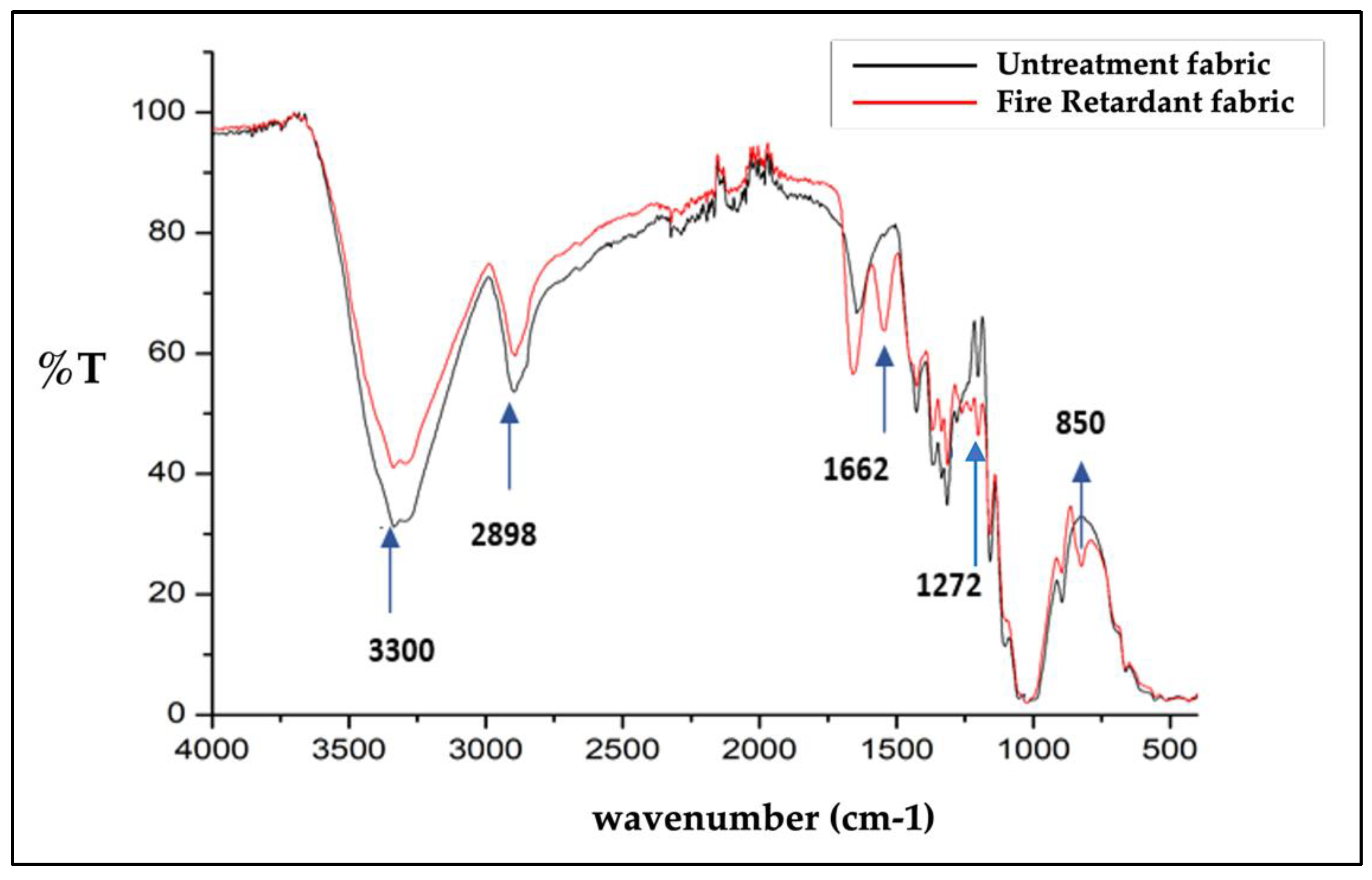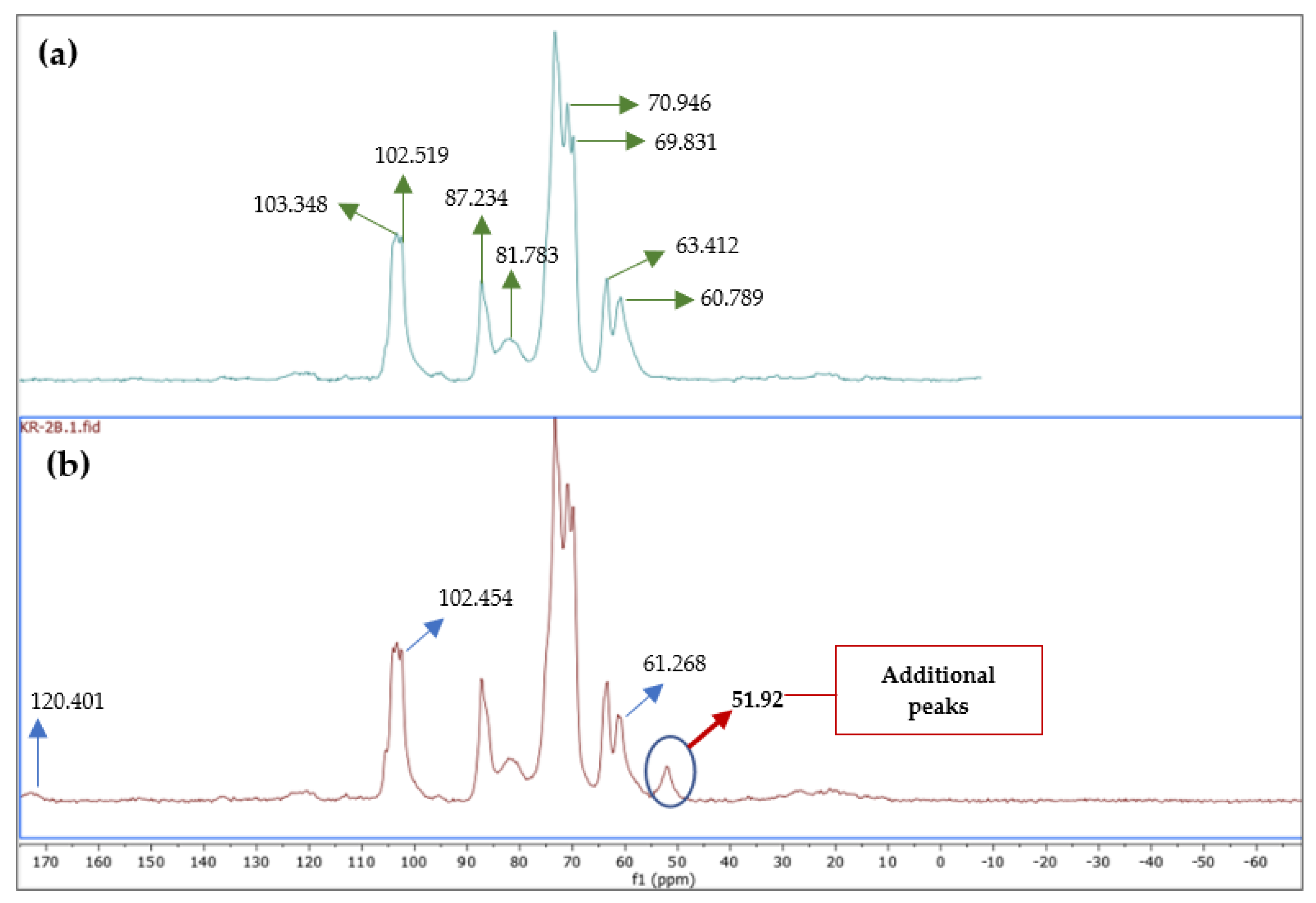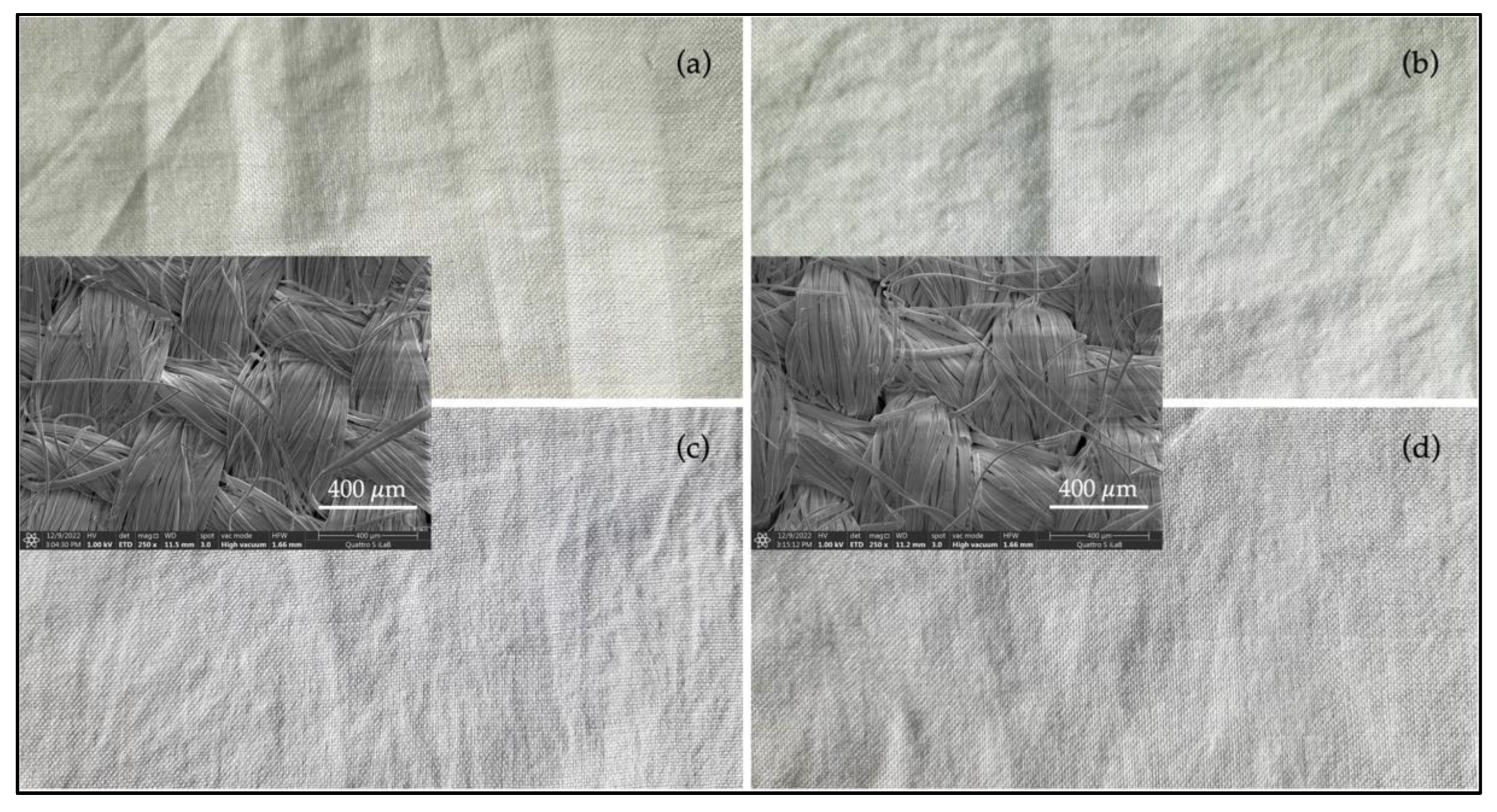Characteristics and Quality of Flame-Retarded Ramie Fabrics for the Development of Functional Textiles
Abstract
:1. Introduction
2. Materials and Methods
2.1. Materials
2.2. Characterization of Ramie Fabric
2.2.1. Peroxide Treatment
2.2.2. Preparation of Flame-Retardant Fabric
2.3. Flammability Testing and Evaluation
2.4. Limiting Oxygen Index (LOI)
2.5. Fourier-Transform Infrared (FTIR) Analysis
2.6. NMR Analysis
2.7. Micrograph Surface Structure Analysis
3. Results and Discussions
3.1. The Structural Properties of the Fabrics
3.2. Flame Retardancy and Flammability
| No. | Material | After Flame Times (s) | After Glow Times (s) | Dripping | Ignition | Char Length (mm) | Reference |
|---|---|---|---|---|---|---|---|
| 1. | Ramie fabric (untreated) | 20 | 78 | No | No | - | this work |
| 2. | Ramie fabric 40%—FR | 0 | 0 | No | No | 30 | this work |
| 3. | Ramie fabric 50%—FR | 0 | 0 | No | No | 15 | this work |
| 4. | Cotton fabric (ASMPEA treated) | 0 | 0 | No | No | 48–64 | [47] |
| 5. | Cotton fabric (untreated) | 6.9 | 44.6 | - | - | - | [48] |
| 6. | Cotton fabric (350 g/L-SPPTMS) | 0 | 0 | - | - | 81 | [48] |
| 7. | Wool fabric (PA treated) | 5–15 | 15–30 | - | - | 150–200 | [49] |
3.3. Tensile Characterization
3.4. Limiting Oxygen Index (LOI)
3.5. Structural Reaction Analysis
3.5.1. FTIR Spectra
3.5.2. NMR
3.6. Morphological Characterization
4. Conclusions
Author Contributions
Funding
Institutional Review Board Statement
Informed Consent Statement
Data Availability Statement
Conflicts of Interest
Abbreviations
References
- Bilir, M.Z.; Gürcüm, B.H. Ballistic wearable electronic vest design. J. Ind. Text. 2018, 47, 1769–1790. [Google Scholar] [CrossRef]
- Sezer Hicyilmaz, A.; Altin, Y.; Bedeloglu, A. Polyimide-coated fabrics with multifunctional properties: Flame retardant, UV protective, and water proof. J. Appl. Polym. Sci. 2019, 136, 47616. [Google Scholar] [CrossRef]
- Abou-Okeil, A.; El-Sawy, S.M.; Abdel-Mohdy, F.A. Flame retardant cotton fabrics treated with organophosphorus polymer. Carbohydr. Polym. 2013, 92, 2293–2298. [Google Scholar] [CrossRef]
- Fiss, B.G.; Hatherly, L.; Stein, R.S.; Friščić, T.; Moores, A. Mechanochemical Phosphorylation of Polymers and Synthesis of Flame-Retardant Cellulose Nanocrystals. ACS Sustain. Chem. Eng. 2019, 7, 7951–7959. [Google Scholar] [CrossRef]
- Ahmad, J.; Zhou, Z. Mechanical properties of natural as well as synthetic fiber reinforced concreate: A review. Constr. Build. Mater. 2022, 333, 127353. [Google Scholar] [CrossRef]
- Gurunathan, T.; Mohanty, S.; Nayak, S.K. A review of the recent developments in biocomposites based on natural fibres and their application perspectives. Compos. Part A Appl. Sci. Manuf. 2015, 77, 1–25. [Google Scholar] [CrossRef]
- Hardjono, H.; Permatasari, D.A.; Sari, V.A. The influence of citric acid addition on the characteristics of biodegradable plastic film form kepok banana peel starch (Musa Acuminata Balbisiana Colla). J. Bahan Alam Terbarukan 2016, 5, 22–28. [Google Scholar] [CrossRef]
- Han, Y.; Zhang, X.; Wu, X.; Lu, C. Flame Retardant, Heat Insulating Cellulose Aerogels from Waste Cotton Fabrics by in Situ Formation of Magnesium Hydroxide Nanoparticles in Cellulose Gel Nanostructures. ACS Sustain. Chem. Eng. 2015, 3, 1853–1859. [Google Scholar] [CrossRef]
- Suhas; Gupta, V.; Carrott, P.; Singh, R.; Chaudhary, M.; Kushwaha, S. Cellulose: A review as natural, modified and activated carbon adsorbent. Bioresour. Technol. 2016, 216, 1066–1076. [Google Scholar] [CrossRef]
- Abdelrahman, M.S.; Khattab, T.A. Development of One-Step Water-Repellent and Flame-Retardant Finishes for Cotton. ChemistrySelect 2019, 4, 3811–3816. [Google Scholar] [CrossRef]
- Hamawand, I.; Sandell, G.; Pittaway, P.; Chakrabarty, S.; Yusaf, T.; Chen, G.; Seneweera, S.; Al-Lwayzy, S.; Bennett, J.; Hopf, J. Bioenergy from Cotton Industry Wastes: A review and potential. Renew. Sustain. Energy Rev. 2016, 66, 435–448. [Google Scholar] [CrossRef]
- Bentis, A.; Boukhriss, A.; Grancaric, A.M.; El Bouchti, M.; El Achaby, M.; Gmouh, S. Flammability and combustion behavior of cotton fabrics treated by the sol gel method using ionic liquids combined with different anions. Cellulose 2019, 26, 2139–2153. [Google Scholar] [CrossRef]
- Jiang, Z.; Wang, C.; Fang, S.; Ji, P.; Wang, H.; Ji, C. Durable flame-retardant and antidroplet finishing of polyester fabrics with flexible polysiloxane and phytic acid through layer-by-layer assembly and sol–gel process. J. Appl. Polym. Sci. 2018, 135, 46414. [Google Scholar] [CrossRef]
- Lin, D.; Zeng, X.; Li, H.; Lai, X.; Wu, T. One-pot fabrication of superhydrophobic and flame-retardant coatings on cotton fabrics via sol-gel reaction. J. Colloid. Interface Sci. 2019, 533, 198–206. [Google Scholar] [CrossRef]
- Palaskar, S.S.; Desai, A.N.; Shukla, S.R. Development of multifunctional cotton fabric using atmospheric pressure plasma and nano-finishing. J. Text. Inst. 2016, 107, 405–412. [Google Scholar] [CrossRef]
- Pan, Y.; Liu, L.; Zhang, Y.; Song, L.; Hu, Y.; Jiang, S.; Zhao, H. Effect of genipin crosslinked layer-by-layer self-assembled coating on the thermal stability, flammability and wash durability of cotton fabric. Carbohydr. Polym. 2019, 206, 396–402. [Google Scholar] [CrossRef] [PubMed]
- Caschera, D.; Toro, R.G.; Federici, F.; Riccucci, C.; Ingo, G.M.; Gigli, G.; Cortese, B. Flame retardant properties of plasma pre-treated/diamond-like carbon (DLC) coated cotton fabrics. Cellulose 2015, 22, 2797–2809. [Google Scholar] [CrossRef]
- Poon, C.K.; Kan, C.W. Effects of TiO2 and curing temperatures on flame retardant finishing of cotton. Carbohydr. Polym. 2015, 121, 457–467. [Google Scholar] [CrossRef] [PubMed]
- Xie, K.; Gao, A.; Zhang, Y. Flame retardant finishing of cotton fabric based on synergistic compounds containing boron and nitrogen. Carbohydr. Polym. 2013, 98, 706–710. [Google Scholar] [CrossRef]
- Lin, D.; Zeng, X.; Li, H.; Lai, X. Facile fabrication of superhydrophobic and flame-retardant coatings on cotton fabrics via layer-by-layer assembly. Cellulose 2018, 25, 3135–3149. [Google Scholar] [CrossRef]
- Qiu, S.; Li, Y.; Li, G.; Zhang, Z.; Li, Y.; Wu, T. Robust Superhydrophobic Sepiolite-Coated Polyurethane Sponge for Highly Efficient and Recyclable Oil Absorption. ACS Sustain. Chem. Eng. 2019, 7, 5560–5567. [Google Scholar] [CrossRef]
- Zhao, H.B.; Chen, M.; Chen, H.B. Thermally Insulating and Flame-Retardant Polyaniline/Pectin Aerogels. ACS Sustain. Chem. Eng. 2017, 5, 7012–7019. [Google Scholar] [CrossRef]
- Ye, D.-D.; Wang, T.; Liao, W.; Wang, H.; Zhao, H.-B.; Xu, S.; Wang, Y.-Z. Ultrahigh-Temperature Insulating and Flame retardant Aerogels from Cationic Amylopectin and Clay via a Facile Route. ACS Sustain. Chem. Eng. 2019, 7, 11582–11592. [Google Scholar] [CrossRef]
- Ortelli, S.; Malucelli, G.; Blosi, M.; Zanoni, I.; Costa, A.L. NanoTiO2 @DNA complex: A novel eco, durable, fire retardant design strategy for cotton textiles. J. Colloid. Interface Sci. 2019, 546, 174–183. [Google Scholar] [CrossRef] [PubMed]
- Liu, Y.; Wang, Q.Q.; Jiang, Z.M.; Zhang, C.J.; Li, Z.F.; Chen, H.Q.; Zhu, P. Effect of chitosan on the fire retardancy and thermal degradation properties of coated cotton fabrics with sodium phytate and APTES by LBL assembly. J. Anal. Appl. Pyrolysis 2018, 135, 289–298. [Google Scholar] [CrossRef]
- Laufer, G.; Kirkland, C.; Morgan, A.B.; Grunlan, J.C. Intumescent multilayer nanocoating, made with renewable polyelectrolytes, for flame-retardant cotton. Biomacromolecules 2012, 13, 2843–2848. [Google Scholar] [CrossRef]
- Wang, X.; Lu, C.; Chen, C. Effect of chicken-feather protein-based flame retardant on flame retarding performance of cotton fabric. J. Appl. Polym. Sci. 2014, 131, 1–8. [Google Scholar] [CrossRef]
- Choi, K.; Seo, S.; Kwon, H.; Kim, D.; Park, Y.T. Fire protection behavior of layer-by-layer assembled starch–clay multilayers on cotton fabric. J. Mater. Sci. 2018, 53, 11433–11443. [Google Scholar] [CrossRef]
- Dittenber, D.B.; GangaRao, H.V. Critical review of recent publications on use of natural composites in infrastructure. Compos. Part A Appl. Sci. Manuf. 2012, 43, 1419–1429. [Google Scholar] [CrossRef]
- Wulandari, A.P.; Awis, V.P.D.; Budiono, R.; Kusmoro, J.; Hidayat, S.S.; Masruchin, N.; Lubis, M.A.R.; Fatriasari, W.; Rachmawati, U. Tensile Strength Improvements of Ramie Fiber Threads through Combination of Citric Acid and Sodium Hypophosphite Cross-Linking. Materials 2023, 16, 4758. [Google Scholar] [CrossRef]
- Yan, H.; Cheng, J.; Fang, Z. Method for Improving Flame Retardant Property of Modified Ramie Fabric. Chinese Patent CN111764154A, 13 October 2020. [Google Scholar]
- Yan, H.; Cheng, J.; Fang, Z.; Zhao, L. A Kind of Three Flame-Retardant Modified Ramie Fabrics of Component LBL Self-Assembly and Preparation Method Thereof. Chinese Patent CN105755836B, 28 November 2017. [Google Scholar]
- Yan, H.; Li, N.; Cheng, J.; Fang, Z. Flame-Retardant Modified Ramie Fabric/Benzoxazine Colophony Laminate and Preparation Method Thereof. Chinese Patent CN106079723B, 31 October 2018. [Google Scholar]
- Sun, Z.; Hou, Y.; Hu, Y.; Hu, W. Effect of Additive Phosphorus-Nitrogen Containing Flame Retardant on Char Formation and Flame Retardancy of Epoxy Resin. Mater. Chem. Phys. 2018, 214, 154–164. [Google Scholar] [CrossRef]
- Repon, M.R.; Siddiquee, N.A.; Jalil, M.A.; Mikucioniene, D.; Karim, M.R.; Islam, T. Flame retardancy enhancement of jute fabric using chemical treatment. Tekstilec 2021, 64, 70–80. [Google Scholar] [CrossRef]
- Klunkin, W.; Hinmo, S.; Thipchai, P.; Rachtanapun, P. Effect of Bleaching Processes on Physicochemical and Functional Properties of Cellulose and Carboxymethyl Cellulose from Young and Mature Coconut Coir. Polymers 2023, 15, 3376. [Google Scholar] [CrossRef] [PubMed]
- ASTM D6413; Standard Test Method for Flame Resistance of Textiles (Vertical Test). ASTM International: West Conshohocken, PA, USA, 2015.
- Cheng, X.-W.; Guan, J.-P.; Chen, G.; Yang, X.-H.; Tang, R.-C. Adsorption and Flame Retardant Properties of Bio-Based Phytic Acid on Wool Fabric. Polymers 2016, 8, 122. [Google Scholar] [CrossRef] [PubMed]
- Dayrit, F.M.; de Dios, A.C. 1H and 13C NMR for the Profiling of Natural Product Extracts: Theory and Applications. In Spectroscopic Analyses-Developments and Applications; BoD–Books on Demand: Norderstedt, Germany, 2017. [Google Scholar] [CrossRef]
- Ismail, A.F.; Rana, D.; Matsuura, T.; Foley, H.C. Membrane Characterization. In Carbon-Based Membranes for Separation Processes; Springer: New York, NY, USA, 2011. [Google Scholar] [CrossRef]
- Castellano, A.; Colleoni, C.; Iacono, G.; Mezzi, A.; Plutino, M.R.; Malucelli, G.; Rosace, G. Synthesis and characterization of a phosphorous/nitrogen based sol-gel coating as a novel halogen- and formaldehyde-free flame retardant finishing for cotton fabric. Polym. Degrad. Stab. 2019, 162, 148–159. [Google Scholar] [CrossRef]
- Passauer, L.; Fischer, S.; Bender, H.; Tech, S.; Wagenführ, A. Verwendung Wasserlöslicher Stickstoff- und Phosphorhaltiger Polysaccharidderivate als Flammschutzmittel, Holzverbundwerkstoff mit Verbesserten Flammschutzeigenschaften sowie Verfahren zu Dessen Herstellung. Deutsches Patent-und Markenamt, DE102012204238B4, 16 March 2012. [Google Scholar]
- Luo, Y.; Geng, Z.; Zhang, W.; He, J.; Yang, R. Strategy for Constructing Phosphorus-Based Flame-Retarded Polyurethane Elastomers for Advanced Performance in Long-Term. Polymers 2023, 15, 3711. [Google Scholar] [CrossRef] [PubMed]
- Salmeia, K.A.; Jovic, M.; Ragaisiene, A.; Rukuiziene, Z.; Milasius, R.; Mikucioniene, D.; Gaan, S. Flammability of Cellulose-Based Fibers and the Effect of Structure of Phosphorus Compounds on Their Flame Retardancy. Polymers 2016, 8, 293. [Google Scholar] [CrossRef] [PubMed]
- Chen, M.J.; Shao, Z.B.; Wang, X.L.; Chen, L.; Wang, Y.Z. Halogen-free flame-retardant flexible polyurethane foam with a novel nitrogen-phosphorus flame retardant. Ind. Eng. Chem. Res. 2012, 51, 9769–9776. [Google Scholar] [CrossRef]
- Wu, D.H.; Zhao, P.H.; Zhang, M.; Liu, Y.Q.; Li, T.K.; Liao, D.X. Synthesis and Flame Retardant Properties of a Novel Monomolecular P-N Intumescent Flame Retardant. Chin. J. Synth. Chem. 2013, 21, 530–533. [Google Scholar]
- Chang, S.C.; Sachinvala, D.; Sawhney, P.; Parikh, D.V.; Jarrett, W.; Grimm, C. Epoxy phosphonate crosslinkers for providing flame resistance to cotton textiles. Polym. Adv. Technol. 2007, 18, 611–619. [Google Scholar] [CrossRef]
- Kong, D.; Liu, J.; Zhang, Z.; Wang, S.; Lu, Z. Preparation of synergistic silicon, phosphorus and nitrogen flame retardant based on cyclosiloxane and its application to cotton fabric. Cellulose 2021, 28, 8115–8128. [Google Scholar] [CrossRef]
- Rusmirović, J.D.; Lukić, V.; Kovačević, T.M.; Bogosavljević, M.; Brzić, S.; Marinković, A.D.; Stevanović, T. Fireproof phosphorylated kraft lignin/polyesterbased composites: Green material for rocket propellant thermal protection systems. Sci. Tech. Rev. 2019, 69, 16–22. [Google Scholar] [CrossRef]
- Chang, S.; Slopek, R.P.; Condon, B.; Grunlan, J.C. Surface coating for flame-retardant behavior of cotton fabric using a continuous layer-by-layer process. Ind. Eng. Chem. Res. 2014, 53, 3805–3812. [Google Scholar] [CrossRef]
- He, W.-L.; Huang, Y.-T.; Gu, L.; Shen, J.-C.; Cheng, X.-W.; Guan, J.-P. Fabrication of P/N/B-Based Intumescent Flame-Retardant Coating for Polyester/Cotton Blend Fabric. Materials 2022, 15, 6420. [Google Scholar] [CrossRef] [PubMed]
- Liu, Z.; Xu, M.; Wang, Q.; Li, B. A novel durable flame retardant cotton fabric produced by surface chemical grafting of phosphorus- and nitrogen-containing compounds. Cellulose 2017, 24, 4069–4081. [Google Scholar] [CrossRef]
- Cilurzo, F.; Selmin, F.; Minghetti, P.; Montanari, L. The effects of bivalent inorganic salts on the mucoadhesive performance of a polymethylmethacrylate sodium salt. Int. J. Pharm. 2005, 301, 62–70. [Google Scholar] [CrossRef]
- Nguyen, M.M.; Al-Abdul-Wahid, M.S.; Fontenot, K.R.; Graves, E.E.; Chang, S.C.; Condon, B.D.; Grimm, C.C.; Lorigan, G.A. Understanding the mechanism of action of triazine-phosphonate derivatives as flame retardants for cotton fabric. Molecules 2015, 20, 11236–11256. [Google Scholar] [CrossRef]
- Wan, C.; Liu, M.; He, P.; Zhang, G.; Zhang, F. A novel reactive flame retardant for cotton fabric based on a thiourea-phosphoric acid polymer. Ind. Crops Prod. 2020, 154, 112625. [Google Scholar] [CrossRef]
- Jia, Y.; Lu, Y.; Zhang, G.; Liang, Y.; Zhang, F. Facile synthesis of an eco-friendly nitrogen-phosphorus ammonium salt to enhance the durability and flame retardancy of cotton. J. Mater. Chem. A 2017, 5, 9970–9981. [Google Scholar] [CrossRef]
- Pethsangave, D.A.; Khose, R.V.; Wadekar, P.H.; Some, S. Novel Approach toward the Synthesis of a Phosphorus-Functionalized Polymer-Based Graphene Composite as an Efficient Flame Retardant. ACS Sustain. Chem. Eng. 2019, 7, 11745–11753. [Google Scholar] [CrossRef]
- Ling, C.; Guo, L. Preparation of a flame-retardant coating based on solvent-free synthesis with high efficiency and durability on cotton fabric. Carbohydr. Polym. 2020, 230, 115648. [Google Scholar] [CrossRef] [PubMed]
- Miller, F.A.; Wilkins, C.H. Infrared Spectra and Characteristic Frequencies of Inorganic Ions. Anal. Chem. 1952, 24, 1253–1294. [Google Scholar] [CrossRef]
- Basak, S.; Samanta, K.K.; Chattopadhyay, S.K. Fire retardant property of cotton fabric treated with herbal extract. J. Text. Inst. 2015, 106, 1338–1347. [Google Scholar] [CrossRef]
- Liao, Y.; Chen, Y.; Wan, C.; Zhang, G.; Zhang, F. An eco-friendly NP flame retardant for durable flame-retardant treatment of cotton fabric. Int. J. Biol. Macromol. 2021, 187, 251–261. [Google Scholar] [CrossRef]
- Wang, H.; Guo, S.; Zhang, C.; Qi, Z.; Li, L.; Zhu, P. Flame Retardancy and Thermal Behavior of Wool Fabric Treated with a Phosphorus-Containing Polycarboxylic Acid. Polymers 2021, 13, 4111. [Google Scholar] [CrossRef]




| No. | Characterization | Woven Fabric | Standards Test |
|---|---|---|---|
| 1. | Weave Type | Plain | SNI 0458:2013; SNI ISO 7211-1:2010 |
| 2. | Thread Number (tex) | 25.26 | SNI ISO 7211-5:2010 |
| 3. | Strand Yarn (strands/inch) | Warp: 52 Weft: 57 | SNI ISO 7211-2:2010 |
| 4. | Fabric Thickness (mm) | 0.28 | SNI ISO 5084:2010 |
| 5. | Fabric Weight (g/m) | 186.97 | SNI ISO 3801:2010 |
| 6. | Fabric Width (cm) | 159.64 | SNI ISO 22198:2010 |
| 7. | Change in Size After Washing (%) | −3.21 | SNI ISO 6330-2015 |
| 8. | Fabric Tensile Strength/2.5 cm (N) | Warp: 249.76 Weft: 207.38 | SNI 0276-2009 |
| 9. | Fabric Tear Strength (n) | Warp: 55.52 Weft: 37.08 | SNI 0521-2008 |
| Criteria Conditions | Classification | ||
|---|---|---|---|
| B1 | B2 | B3 | |
| Char length (cm) | ≤15 | ≤20 | No special treatment |
| After flame time (s) | ≤5 | ≤15 | |
| After glow time (s) | ≤15 | ≤30 | |
| No. | Material Fabric | Tensile Strength (MPa) |
|---|---|---|
| 1. | KR-T01—non-FR (untreated) | 56.69 ± 5.84 |
| 3. | KR-T01—50% FR | 40.60 ± 3.32 |
| No. | Material (Trademark) | Treatment | LOI (%) | Reference |
|---|---|---|---|---|
| 1. | Ramie fabric | Untreated | 22 | this work |
| 2. | Ramie fabric | Finished flamatic 50% | 29 | this work |
| 3. | Cotton fabric | Spptms | 28.5 | [48] |
| 4. | Cotton fabric | Coated T/C blend | 27.1 | [51] |
| 5. | Cotton fabric | Finished | 27.4 | [52] |
| 6. | Wool fabric | Bio-based phytic acid | 23.6–27 | [49] |
Disclaimer/Publisher’s Note: The statements, opinions and data contained in all publications are solely those of the individual author(s) and contributor(s) and not of MDPI and/or the editor(s). MDPI and/or the editor(s) disclaim responsibility for any injury to people or property resulting from any ideas, methods, instructions or products referred to in the content. |
© 2024 by the authors. Licensee MDPI, Basel, Switzerland. This article is an open access article distributed under the terms and conditions of the Creative Commons Attribution (CC BY) license (https://creativecommons.org/licenses/by/4.0/).
Share and Cite
Wulandari, A.P.; Karlina, E.; Tanudjaja, E.; Rohmat, A.; Kusmoro, J.; Fadhlillah, M.; Somantri, K.; Sahroni, R.; Fatriasari, W. Characteristics and Quality of Flame-Retarded Ramie Fabrics for the Development of Functional Textiles. Materials 2024, 17, 1416. https://doi.org/10.3390/ma17061416
Wulandari AP, Karlina E, Tanudjaja E, Rohmat A, Kusmoro J, Fadhlillah M, Somantri K, Sahroni R, Fatriasari W. Characteristics and Quality of Flame-Retarded Ramie Fabrics for the Development of Functional Textiles. Materials. 2024; 17(6):1416. https://doi.org/10.3390/ma17061416
Chicago/Turabian StyleWulandari, Asri Peni, Erlin Karlina, Eric Tanudjaja, Abdul Rohmat, Joko Kusmoro, Muhammad Fadhlillah, Karlina Somantri, Roni Sahroni, and Widya Fatriasari. 2024. "Characteristics and Quality of Flame-Retarded Ramie Fabrics for the Development of Functional Textiles" Materials 17, no. 6: 1416. https://doi.org/10.3390/ma17061416








